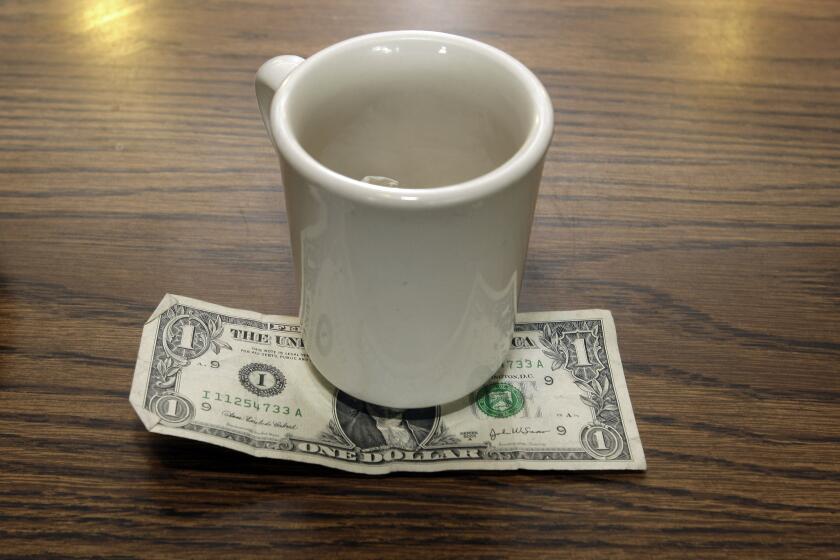GOOD FOOD : Sugar: Surprisingly Innocent
- Share via
White sugar is that great rarity among foods, a genuinely pure product. Free of contaminants, including all proteins, complex carbohydrates, vitamins and minerals, between 99% and 99.8% sucrose, it is absolutely uniform and absolutely dependable.
Though all of it comes from beet roots or the stems of sugar cane, the finished product is so highly refined that its connection with nature is difficult to imagine. Sugar is a concentrated source of calories that has no other nutritional value, which has led many medical experts to blame it for unbalancing the American diet. And since sugar, like salt, has been overused as a flavoring, food lovers often blame it for unbalancing American cuisine.
But while sugars--these days the bulk of them derived from corn--are indeed abused, especially by the makers of processed foods, plain white sugar is innocent. Though not “good for you,” it’s not “bad for you” either. It doesn’t even lead as surely to tooth decay as was once thought--in that department you’re worse off chewing raisins. And sugar is endlessly useful, one of the most versatile items in the home cook’s pantry.
It’s certainly a shape-shifter. With a little help from heat and water, sugar can have any texture from gooey taffy to crunchy toffee, from rock candy’s diamond lumps to cotton candy’s soft clouds. Add lots of sugar to egg whites and make crisp meringue shells; add less and make fluffy marshmallows. These confections, being fat-free, are a special boon to lovers of sweets who are trying to modify their diets without giving up dessert.
Though sugar can also have more than one taste--once it’s browned, it’s caramel--the great advantage of pure sucrose is its absolute neutrality. Honey, maple syrup and concentrated fruit juice are all very nice in their ways, but only sugar sweetens without changing original flavors. When green vegetables such as peas, asparagus and green beans have become overgrown, or are less than freshly harvested, a tiny dash of sugar can help restore their lost sweetness, just as a small amount of added sugar can intensify the flavor of fruit that might otherwise be flat. Assuming proper restraint is used, the sugar will remain anonymous.
Sugar in bread dough has indeed been overdone; the stuff you use to mop up the gravy should not taste like cake. But a small amount of sugar in baked goods can confer large advantages: It aids browning, promotes tenderness and increases storage life.
In fact, when used in quantity, sugar is a powerful preservative. It inhibits bacterial growth in such products as jams and candied fruit; and it accelerates fermentation in homemade cordials, tutti-frutti and other alcoholic products. It’s a tenderizer too. The sugar used in bacon and ham curing helps counteract the hardness caused by salt.
When food critics want to complain about the over-sweetening of America, salad dressing is often singled out as the most egregious example. Of all dishes that should be sugar-free, surely salad is at the top of the list, they argue. But again the problem is abuse, not use itself. Cloying dressings sweet enough to pour on a dessert are a disgrace to decent lettuce, but nobody complains about balsamic vinegar, a decidedly sweet product. That famous tiny dash can be exactly what’s needed. Sugar gentles acidity, especially in modern, low-fat dressings that skimp on the olive oil.
Sugar gentles hot peppers too. Indian, Thai and Indonesian cuisines all balance fiery tastes with sweet ones, and hapless eaters of too-hot peppers should know that a spoonful of plain white sugar, eaten straight, is the most efficient distraction.
Sugar was a medicine when first brought to Western Europe. Sugar-coated almonds, which date from the 13th Century, were among the earliest recipes devoted to pure pleasure. The original formula, still in use, involves carefully boiled syrup and is considerably fussier than this one. Gratification still isn’t instant--the almonds take a while to bake--but fussing is practically nil.
EASY SUGARED ALMONDS
Butter
2 egg whites
1 1/2 pounds whole blanched almonds
1 cup sugar
2 tablespoons cornstarch
Dash salt
Thickly butter large jellyroll pan. Set aside.
Beat egg whites in large bowl until well mixed, pale and frothy but not yet solidified into foam. Stir in almonds, making sure all are completely covered. Set bowl aside about 10 minutes.
Stir almonds again and drain off any excess egg white. Thoroughly combine sugar, cornstarch and salt. Add mixture to almonds and stir until evenly coated.
Spread nuts on prepared sheet and bake at 250 degrees 20 minutes, then use metal spatula to turn and separate nuts. Continue baking 70 to 80 minutes more, stirring every 20 minutes, until nuts are toasted and coating is lightly golden and very crisp.
Nuts will be soft when hot, so remove nuts and let cool before tasting. Makes about 6 cups.
Variation: For Spiced Sugared Almonds add 1 1/4 teaspoons ground cinnamon, 3/4 teaspoon ground ginger, 1/2 teaspoon ground mace and dash cloves to sugar, cornstarch and salt mixture.
More to Read
Eat your way across L.A.
Get our weekly Tasting Notes newsletter for reviews, news and more.
You may occasionally receive promotional content from the Los Angeles Times.









